ICYMI: Highlights from the week that was Oct. 22 – Oct. 28, 2017
No one can keep up with everything, so let us do it for you. We’ll gather the top Smithsonian stories from across the country and around the world each week so you’ll never be at a loss for conversation around the water cooler.
If the past informs the present, the present predicts the future, so we took a look at the future of food, the fate of family heirlooms and whether philanthropy can cleanse a questionable past.
Astronomers Measure Milky Way with Radio Waves
Voice of America, (via Associated Press), Oct. 23
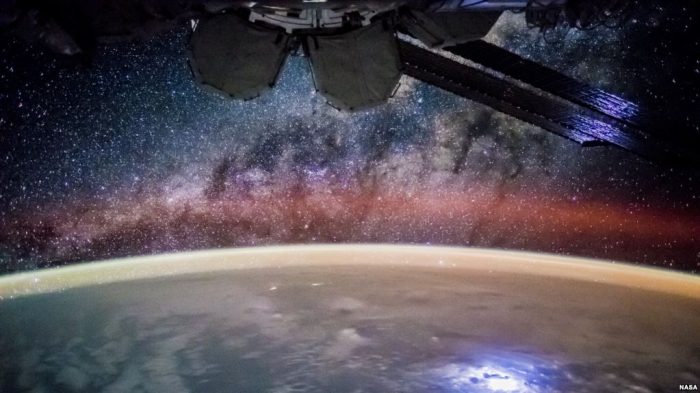
An astronaut took this broad, short-lens photograph of Earth’s night lights and Milky Way while looking out over the remote reaches of the central equatorial Pacific Ocean.
A collection of radio telescopes that spans thousands of miles and is remotely operated from central New Mexico has measured a span of 66,000 light-years (one light-year is equal to 6 trillion miles) from Earth across the Milky Way’s center to a star-forming area near the edge of the other side of the galaxy.
Astronomers say they hope to measure additional points around the galaxy to produce a map – the first of its kind – over the next decade. Read more from Voice of America.
The future of American food is here, and it’s chicken tikka poutine and meatball dumplings
The Washington Post, Oct. 24

Clockwise from left, Danny Lee at ChiKo in Washington; sisters Hanna and Marian Cheng at Mimi Cheng’s Dumplings in New York City; Daniela Soto-Innes of Cosme and Atla in New York; Wesley Avila of the food truck Guerrilla Tacos in Los Angeles; Preety Mistri of Juhu Beach Club and Navi Kitchen in the San Francisco Bay area. (Photos: Top left, John Rorapaugh/Leading DC; Top right, Deb Lindsey for The Wahsington Post; Bottom left, Fiamma Piacentin; Bottom middle, Dylan James Ho and Jeni Ofuso; Bottom right, Alanna Hale)
Ask Preeti Mistry why she cooks Indian food, and you can almost hear the frustration in her voice.
“Well,” she explains without hesitation, “it all goes back to chai.”
Chai?
“This is a drink my family, and my grandparents, have been drinking every morning and every afternoon their entire lives,” says the mohawked chef of Oakland’s Juhu Beach Club and Navi Kitchen in Emeryville. And one day, mysteriously, the Ur-beverage of South Asia began turning up at every coffee shop she encountered.
We weren’t yet using terms like cultural appropriation, but “chai tea” marked something of a political awakening. “Why,” she wondered, “are all these white people making money off it?” Read more from Lavanya Ramanathan for The Washington Post.
Private Equity Billionaires Hand Over Carlyle Group To New Leaders
Forbes, Oct. 25
Billionaire David Rubenstein has had a rock on the front lawn of his Nantucket vacation home that reads “I would rather be working.” The co-founder of the Carlyle Group has been known to fly 250 days a year, beating the bushes across the world to raise new funds for his private equity firm.
But on Wednesday Rubenstein announced that he would be stepping down at the end of the year from the co-chief executive position of the Carlyle Group, the firm he co-founded 30 years ago. At the age of 68, Rubenstein will continue to work as co-executive chairman of the firm and his schedule will certainly remain busy as we works on various projects, including his own Bloomberg TV television show. Read more from Nathan Vardi for Forbes.
Go Behind the Scenes of 9 Museums With These Great Online Web Series
These nine museums are using online video series to take viewers behind the scenes of their collections.
Hyperallergic, Oct. 19
How much of a museum do you really see when visiting its galleries? So much at an institution happens behind the scenes, whether conservators preserving objects for display, or researchers journeying into the field. Many museums have been using online videos to bring these stories to the public. Here are nine series to watch: Read more from Allison Meier for Hyperallergic.
Philanthropy on OxyContin: Does Charity Cleanse This Family’s Complicity in the Opioid Crisis?
Nonprofit Quarterly, Oct. 26
While the Sackler family may not have the wealth or visibility of a Gates or Zuckerberg, with assets of $13 billion, the nation’s 19th wealthiest family is an important player in philanthropy. Especially within the art world, the Sackler influence is hard to miss. Less visible, however, explains Patrick Radden Keefe in the New Yorker, is the role of the Sackler family business in promoting OxyContin, a drug that has led to the death of nearly 200,000 Americans. Read more from Steve Dubb for Nonprofit Quarterly.
Massive Air and Space Museum renovations expected to begin next summer
The Washington Post, Oct. 25
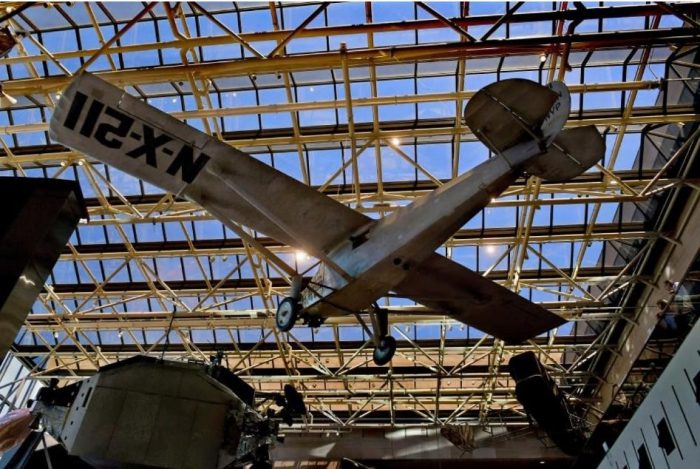
Lindbergh’s Spirit of St Louis hangs in the Natonal Air and Space Museum (Photo by Michael S. Williamson / The Washington Post)
The Smithsonian will begin an almost $1 billion renovation of the National Air and Space Museum next summer with the closing of the western side of the building, officials announced Wednesday.
Museum officials are waiting for Congress to provide funding for the first part of a seven-year, $650 million renovation that will be completed in stages to allow the city’s most visited museum to remain open. Smithsonian Secretary David Skorton said officials are cautiously optimistic that their request will be granted, but he said it is unclear if the project will move forward without it. Read more from Peggy McGlone for The Washington Post.
Baltimore artist Amy Sherald, chosen to paint Michelle Obama portrait, adjusts to national spotlight
The Baltimore Sun, Oct. 27

The Baltimore artist Amy Sherald knew for more than a year that she had been selected to paint the portrait that would make her career. (Amy Davis / Baltimore Sun video)
Baltimore artist Amy Sherald has known for more than a year that she had been selected to paint a portrait that could instantly make her career.
But until the Smithsonian Institution announced publicly this month that the 44-year-old had received the commission to paint first lady Michelle Obama’s official portrait, the artist had to keep her big news under wraps and go about her daily business as if her name weren’t about to become known to ordinary Americans coast to coast. Read more from Mary Carole McCauley for the Baltimore Sun.
Experts have uncovered remains at the first permanent English colony. But whose bones are they?
The Washington Post, Oct. 27
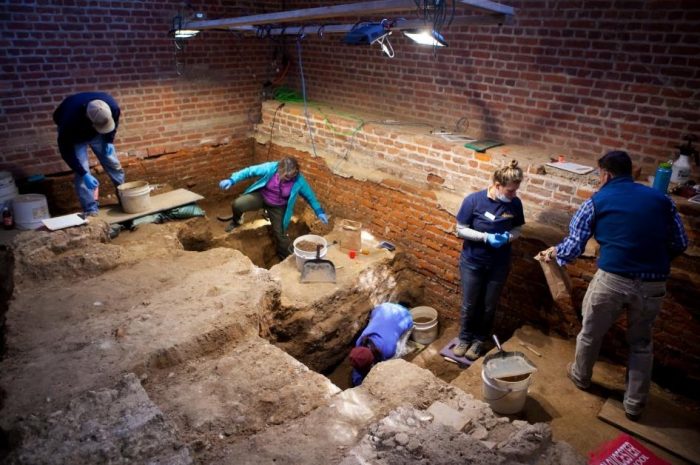
Archaeologists and anthropologists uncover graves inside the church within the fort at Historic Jamestown. They are searching for the graves of people who were important to the establishment and survival of the early colony. (Timothy C. Wright for The Washington Post)
The ancient thigh bone was that of a robust man, a chap in his 40s, with wear and tear in his joints and a hip socket that showed he had been a horseman and a man of status.
Could these be the remains of the long-lost lord — the savior of the English colony here, the aristocrat who died at sea, and whose body was likely carried to Virginia in a cask of wine?
Was this Thomas West, better known as Lord De La Warr, whose name — Americanized to Delaware — has left its imprint on the national landscape?
“I’m not sure,” Kari Bruwelheide, a Smithsonian Institution anthropologist, said as she held the limb under the fluorescent lights at a special laboratory here. Read more from Michael Ruane for The Wahsington Post.
Mysterious object seen speeding past sun could be ‘visitor from another star system’
If its origins are confirmed, the asteroid or comet, named A/2017 U1, will be the first object known to come from elsewhere in the galaxy, say astronomers
The Guardian, Oct. 27

A false-colour image of the object, which appears as a faint point of light in the centre. The streaks are stars, caused by the telescope tracking the object. Photograph: Alan Fitzsimmons/Queen’s University Belfast/Isaac Newton Group La Palma
A mysterious object detected hurtling past our sun could be the first space rock traced back to a different solar system, according to astronomers tracking the body.
While other objects have previously been mooted as having interstellar origins, experts say the latest find, an object estimated to be less than 400m in diameter, is the best contender yet.
“The exciting thing about this is that this may be essentially a visitor from another star system,” said Dr Edward Bloomer, astronomer at the Royal Observatory Greenwich. Read more from Nicola Davis for The Guardian.
‘All Is Not Lost’: These Experts Help Save Hurricane-Soaked Heirlooms
NPR, Oct. 28
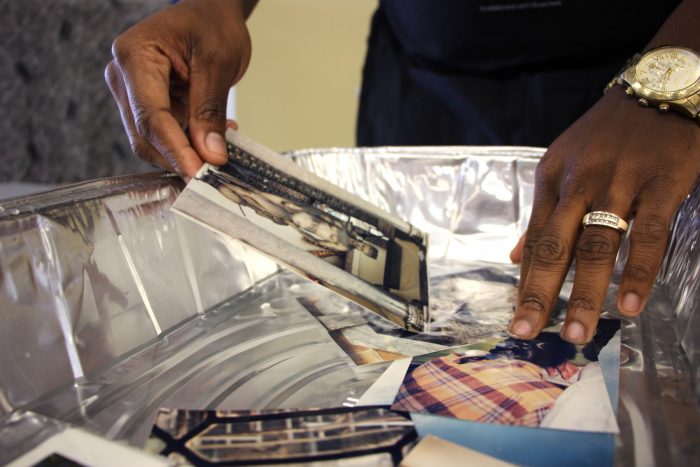
National Museum of African American History and Culture curator Teddy Reeves demonstrates a method of salvaging damaged photos at a workshop in Beaumont, Texas following Hurricane Harvey. (Photo by Allison Lee/Houston Public Media)
When you escape a catastrophe with the clothes on your back and your dog in your arms, people sometimes try to comfort you by saying the rest are “things” and things can be replaced. But, some things can’t be — a family photo album, a scrapbook, grandma’s quilt. That’s what people in Houston are dealing with as they try to put their lives back together after Hurricane Harvey.
And now, a small team of experts from places like the Federal Emergency Management Agency, the Small Business Administration and the Smithsonian are trying to help. Teddy Reeves is one of a group of experts at tables inside a former Goodwill store in Beaumont, Texas. He’s normally a curator at the National Museum of African American History and Culture in D.C., but here he’s part of the joint Smithsonian and FEMA Heritage Emergency National Task Force. Read more and listen to the full story from NPR’s “All Things Considered.”
The Smithsonian saved a statue Lincoln praised. Now you can judge it for yourself.
The Washington Post, Oct. 27
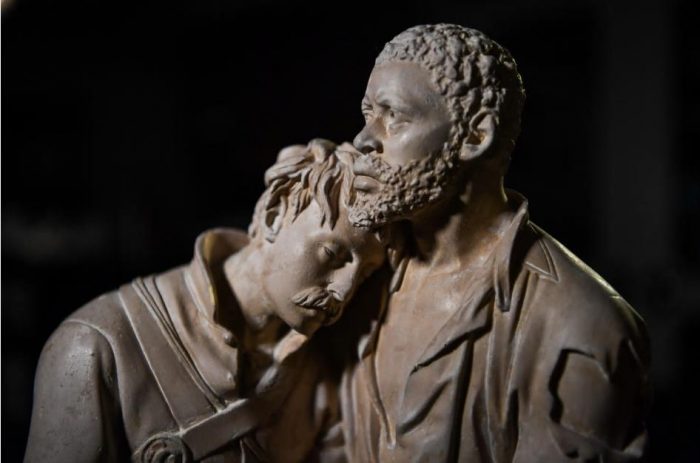
“The Wounded Scout, a Friend in the Swamp” is an 1864 sculpture by John Rogers that depicts a runaway slave aiding an injured Union soldier, and it was a piece of art admired by Abraham Lincoln. (Salwan Georges / The Washington Post)
The summer before the end of the Civil War, sculptor John Rogers created a statuette of a runaway slave aiding an injured, white Union soldier. While the black man in the sculpture keeps an eye out for slave catchers and Confederates, a copperhead snake, symbolizing the Northern “copperhead” politicians who opposed the war, threatens to strike.
Rogers, a white man, is famous for making affordable art available to middle-class families in the 19th century. So, like Rogers’s other works, there isn’t just one edition of this statuette, titled “The Wounded Scout, a Friend in the Swamp.” Rogers used moldings to mass-produce copies, and it became a widely collected artwork from the war, praised by President Abraham Lincoln. Read more from Becky Little for The Washington Post.
Posted: 29 October 2017






